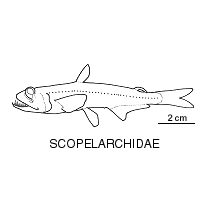- Classification
- ACTINOPTERYGII
- AULOPIFORMES
- SCOPELARCHIDAE
-
Fish Classification
-
Class
ACTINOPTERYGII Ray-finned fishes -
Order
AULOPIFORMES Lizardfishes ... -
Family
SCOPELARCHIDAE Pearleyes
Family SCOPELARCHIDAE
More Info
|
Family Taxonomy |
A relatively small family with five genera and about 18 species. |
|
Family Distribution |
Found worldwide in all oceans except the Arctic and Mediterranean seas. Pearleyes inhabit the mesopelagic zone, usually in depths between 500-1000 m. They undertake daily vertical migrations towards surface waters to feed at night. |
|
Family Description |
Dorsal fin 5-10; Anal fin 17-39; Pectoral fin 18-28; Pelvic fin 9: Caudal fin 1+9+8+1; Branchiostegal rays 4+4; Vertebrae 40-65. Body short to somewhat elongate, shallow to deep, slightly compressed; jaws large, tongue with a row of large teeth that are hooked posteriorly; scales cycloid, lateral line distinct with large pores. |
|
Family Size |
Small to medium-sized fishes reaching 35 cm. |
|
Family Feeding |
Pearleyes are voracious predators, feeding on other deep-sea fishes. |
|
Family Reproduction |
Pearleyes are simultaneous hermaphrodites, with each individual having fully functional male and female reproductive organs - ovitestes. |
|
Family Commercial |
Pearleyes are uncommon deep-sea fishes with no interest to fisheries. They are preyed upon by some of the larger sport fishes. |
|
Family Remarks |
Images and MRI scans of the Shortfin Pearlyeye, Scopelarchus analis, can be viewed online at the Digital Fish Library. Pearleyes have a fossil record extending back to the Upper Cretaceous Period, |
|
Author |
Dianne J. Bray |
References
Collin, S.P., Hoskins, R.V. & Partridge, J.C.. 1998. Seven retinal specializations in the tubular eyes of the deep-sea pearleye, Scopelarchus michaelsarsi: a case study in visual optimisation. Brain, Behavior and Evolution 51: 291–314.
Davis, M.P. 2010. Evolutionary relationships of the Aulopiformes (Euteleostei: Cyclosquamata): a molecular and total evidence approach. pp. 431-470 in Nelson, J.S., Schultze, H.-P. & Wilson, M.V.H. Origin and Phylogenetic Interrelationships of Teleosts. München, Germany : Verlag Dr. Friedrich Pfeil 480 pp.
Davis, M.P. 2015. Evolutionary relationships of the deep-sea pearleyes (Aulopiformes: Scopelarchidae) and a new genus of pearleye from Antarctic waters. Copeia 2015(1): 64-71.
Digital Fish Library http://www.digitalfishlibrary.org/library/ViewSpecies.php?id=266
Goody, P.C. 1969. The relationships of certain Upper Cretaceous teleosts with special reference to the myctophoids. Bull. Brit. Mus. (Nat. Hist.) Geol., Suppl. 7, 255 pp.
Johnson, R. K. 1974. A revision of the alepisauroid family Scopelarchidae (Pisces: Myctophiformes). Fieldiana Zoology 66: i-ix + 1-249.
Johnson, R. K. 1982. Fishes of the families Evermannellidae and Scopelarchidae: systematics, morphology, interrelationships, and zoogeography. Fieldiana Zoology (New Series) No. 12: i-xiii + 1-252.
Johnson, R.K. 1984. Scopelarchidae, In Whitehead, P.J.P., M.-L. Bauchot, J.-C. Hureau, J.G. Nielsen & E. Tortonese. Fishes of the North-eastern Atlantic and the Mediterranean. Vol. 1. UNESCO, p. 1-510.
Johnson, R. K. 1986. Family No. 77: Scopelarchidae (pp. 265-267), In Smith, M.M. & P.C. Heemstra. Smiths' Sea Fishes. Macmillan, Johannesburg, South Africa. i-xx + 1-1047, Pls. 1-144.
Johnson, R.K. & Eschmeyer, W.N. 1998. P. 126, in Paxton, J.R. & Eschmeyer, W.N.. ed. Encyclopedia of Fishes. San Diego: Academic Press.
Wagner, H.J., Frӧhlich, E., Negishi, K. & Collin, S.P. 1998. The eyes of deep-sea fish II: functional morphology of the retina. Progress in Retinal and Eye Research 17: 637–685.









